Daniel Hopfer, Germany, ca. 1530
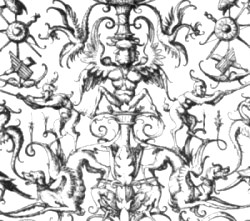
detail
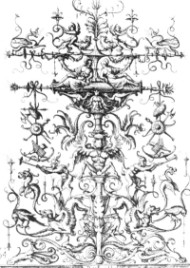
| ANNE WANNER'S Textiles in History / book reviews, articles |
| The
Magic World of the Grotesque 16th and 17th century Grotesques in the Applied Art of Western Europe from the Hermitage Collection by T.H. Kossourowa St. Peterburg, 2000 151 pages, catalogue of 174 objects, most of them in coloured photos ISBN:5-88654-122-5 |
| Engraving,
ornamental pattern, Daniel Hopfer, Germany, ca. 1530
|
|
| The present catalogue accompanies an exhibition which will be shown in the Hermitage Museum next year. It concerns the collection of Western European applied art of the Hermitage, which is little known not only abroad but also in Russia. The exhibition is devoted to the most characteristic ornament of the Renaissqance era - the grotesque. Altogether 174 objects from the sixteenth and seventeenth centuries will be exhibited, most of them for the first time. |
| The ornament of the
grotesque first flourished in classical
antiquity, then fell into oblivion, it re-appeared in
Italy in the fifteenth c. For its name it is indepted to
the archeological excavations of Roman ruins, known as
grottoes. In 1480 in one such grotto the famous golden
House of nero was discovered. In Manierist Western European art the idea of absurdity increasingly permeated the grotesque and in sixteenth-century France it experienced a new revival espescially in the interior decoration of the royal chateau of Fontainebleau. The italian development also left a mark on the development of the grotesque in Germany in the major centres of ornamental engravings in Augsburg and Nuremberg. |
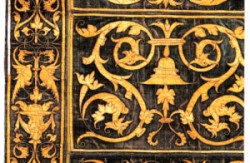 Pillow
case featuring acanthus scrolls on the border |
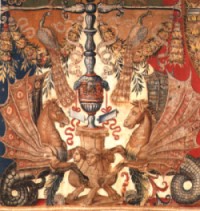 Tapestry:
Spring-Venus, unknown workshop, |
| In tapestries the grotesque developed into an autonomous ornamental genre. The ornament was used to decorate the borders of subject compositions |
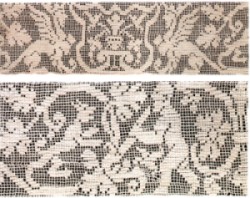 Detail
of |
Crimson
band with depictions of gryphons and birds |
| For embroidery
one can call the grotesque era indeed a "golden
age". Gold and silver embroidery in relief imparted
to the pattern the volume and monumentality,
characteristic of sculptural reliefs. The use of "or
nue" technique brings embroidery close to paintings.
In applique work the masters of embroidery used contrasts of texture and colour. Amateur needlewomen especially favored Assisi work. In drawn work and filet technique the pattern was executed on white linen or filet net. In religious embroidery grotesques decorated alter frontals or orphreys of vestments. |
|
|
| The grotesque can be
found in all kinds of decorative art. It was
used for decoration of panelled walls, in embellishing of
furniture, in majolica-producing centres like those of
Faenza, Siena and Urbino. The Ornament can be found in
Limoges enamels as well. It also established itself in
the decoration of gold- and silverwork, it was used in
vases carved from hard species of stone. Also the history of arms and armour is linked with general tendencies of development in decorative and applied art: the Hermitage collection contains a series of embossed helmets, shields, pieces of armour and metal covers for saddles. Firearms from the second half of sixteeenth century were decorated, the grotesque being one of the component parts of the ornament. |
| home content | Last revised August 3, 2001 | For further information contact Anne Wanner wanner@datacomm.ch |